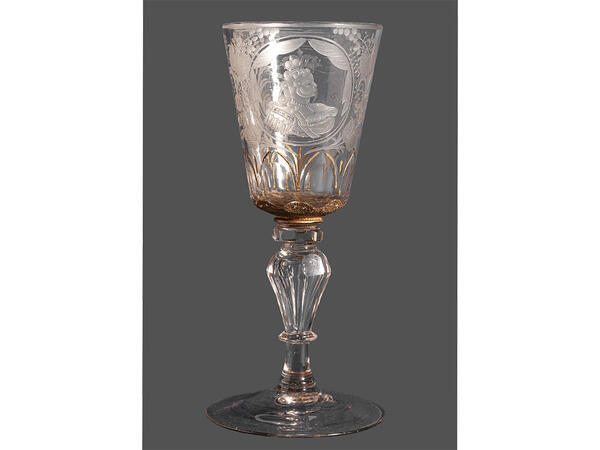The Saint Petersburg State Plant was built on the banks of the Fontanka River by the English merchant William Elmsel in 1735. He transferred employees and equipment of the Yamburg and Zhabinsky factories, which he had previously rented, to this plant. After Elmsel’s death in 1738, the plant was placed under state treasury funding, and management of the Palace Cabinet.
By the order of the Senate, in 1755, the glass production was transferred out of the capital to the city of Yamburg, and in 1774, to the settlement Nazya, near Schlusselburg. In 1777, the plant was taken into “timeless and hereditary possession” of Grigory Potemkin. A few years later, the prince moved the plant to his estate in the settlement of Ozerki, just outside Saint Petersburg — for this reason, it was nicknamed “the Potemkin plant”. After Potemkin died in 1792, the plant returned to state-owned management and became known as the Imperial Glass Factory. In 1870, it ceased to be an independent plant and became part of the Imperial Porcelain Factory.
The factory’s products were mainly ordered by the Imperial Court. A wide variety of tableware was manufactured for the royal family: glasses, shot glasses, wine glasses, shtof-bottles, cups, teapots, goblets with lids. The factory also produced mirrors and window glass. Some of the items were sent to European monarchs and aristocracy as gifts from Russian rulers. The factory sold its products to individuals in the factory’s store and in several merchant shops, as well as during all-Russian trade fairs.
The faceted and carved glass of the Petersburg factory was colorless and shiny. It was called “crystal glass”, although it did not contain lead. Manganese was used for decolorization of glass. The plant performed engraving and etching of drawings, relief carving and faceting, and gilding as well.
The goblet displayed in the collection of the museum is classified as the baroque tableware. It was made from potash glass with a pink tint, which is more durable and shinier compared to other varieties of this material. The faceted leg resembles a shaped post-column — a baluster, and in the lower part of the cone-shaped body of the goblet, there is faceting in the form of “arches”. The entire bottom of the goblet body is covered with gilding. On the surface of the goblet, the craftsmen engraved a large and clear portrait of Empress Elizabeth Petrovna and a monogram with her crown in two medallions. The space around the medallions is decorated with a floral pattern.
By the order of the Senate, in 1755, the glass production was transferred out of the capital to the city of Yamburg, and in 1774, to the settlement Nazya, near Schlusselburg. In 1777, the plant was taken into “timeless and hereditary possession” of Grigory Potemkin. A few years later, the prince moved the plant to his estate in the settlement of Ozerki, just outside Saint Petersburg — for this reason, it was nicknamed “the Potemkin plant”. After Potemkin died in 1792, the plant returned to state-owned management and became known as the Imperial Glass Factory. In 1870, it ceased to be an independent plant and became part of the Imperial Porcelain Factory.
The factory’s products were mainly ordered by the Imperial Court. A wide variety of tableware was manufactured for the royal family: glasses, shot glasses, wine glasses, shtof-bottles, cups, teapots, goblets with lids. The factory also produced mirrors and window glass. Some of the items were sent to European monarchs and aristocracy as gifts from Russian rulers. The factory sold its products to individuals in the factory’s store and in several merchant shops, as well as during all-Russian trade fairs.
The faceted and carved glass of the Petersburg factory was colorless and shiny. It was called “crystal glass”, although it did not contain lead. Manganese was used for decolorization of glass. The plant performed engraving and etching of drawings, relief carving and faceting, and gilding as well.
The goblet displayed in the collection of the museum is classified as the baroque tableware. It was made from potash glass with a pink tint, which is more durable and shinier compared to other varieties of this material. The faceted leg resembles a shaped post-column — a baluster, and in the lower part of the cone-shaped body of the goblet, there is faceting in the form of “arches”. The entire bottom of the goblet body is covered with gilding. On the surface of the goblet, the craftsmen engraved a large and clear portrait of Empress Elizabeth Petrovna and a monogram with her crown in two medallions. The space around the medallions is decorated with a floral pattern.



